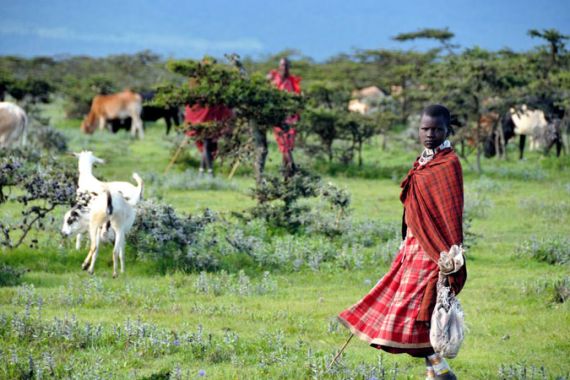Tanzania’s conservation concerns do not excuse violations of Maasai rights
Biodiversity preservation in conservation areas does not require the forced relocation of Indigenous communities.
Published On 9 Aug 20249 Aug 2024Maasai girl and goats in Tanzania [Peter Greste/Al Jazeera]
“We are tired of moving.” This is what several Maasai men and women residing in the Endulen village in Tanzania’s Ngorongoro Conservation Area (NCA) told us last July when we asked them about the government’s ongoing efforts to relocate their community.
“Our grandfathers left Serengeti for conservation,” a local councillor said. “Our fathers lived inside the Ngorongoro Crater and they were removed from there, too. We worry about moving again. We want to have a stable life.”
Keep reading
list of 4 itemsend of list
The Ngorongoro Conservation Area feels like a place outside of time with its lush and otherworldly Ngorongoro Crater, and Maasai boma – traditional homesteads – scattered along winding roads and tucked into hillsides. The conservation area is a UNESCO World Heritage Site and has prehistoric footprints of early upright walking humans as well as a rich mixture of wildlife roaming in and outside the crater. Indigenous Maasai have lived there for generations, but Tanzania’s government has plans to change that, flagging the increase of people and livestock within the area as a conservation concern.
Since 2021, the government has moved and resettled hundreds of people from the conservation area in northern Tanzania to Msomera, a village near the country’s eastern coast. The government claims the relocations are voluntary and touts the measure as promoting conservation.
Human Rights Watch research, conducted since 2022, however, found that the relocations are far from voluntary and that the government has undermined the rights of Maasai residents from both the conservation area and Msomera, including rights to education, healthcare and to preserving their culture.
The government has used several tactics to push residents out of their homes.
For example, it has systematically reduced the availability of adequate education and health services, which were already fewer and of poorer quality than elsewhere in the country.
In 2022, it downgraded Endulen Hospital to a mere dispensary. The 110-bed hospital managed by the Catholic Church since 1965 was the only hospital providing comprehensive medical services in the area. Now it has such a serious shortage of medicines that staff dole out pain and fever relievers for every ailment, residents and staff told us.
The government has refused to release funds or issue permits to improve and renovate schools in the area, many of which have old and dilapidated buildings, overflowing latrines and not enough desks.
The authorities have also restricted movement in and out of the conservation zone, arbitrarily requiring residents to show various types of identification to enter the area. They have restricted residents, who depend primarily on herding livestock for their income, from grazing animals in specific areas and also blocked their access to important cultural and traditional sites. Government rangers indiscriminately attack, beat and harass residents who don’t comply. The authorities have denied entry to nongovernmental organisations or followed and monitored their representatives in the area, effectively blocking them from supporting the affected communities.
Despite government claims the relocations are voluntary, officials have not sought the free, prior and informed consent of Indigenous communities as required under international human rights law. Residents said the government did not properly consult them during and after the review of a multiple land-use plan for the conservation area in 2018, and refused to consider alternatives to relocation. When Prime Minister Kassim Majaliwa met with community leaders in February 2022, people present said there was no discussion or consultation and he only gave instructions on how to register for relocation.
Ultimately the government decided where people would be relocated to, and built houses without any input from affected communities. In Msomera, the government has provided each relocated family with a three-room house and about two to five acres (0.8 to 2 hectares) of land to farm, in addition to constructing and renovating roads, a primary school, dispensary, postal service, police post, water supply system, electricity, and a cellular network to service the area.
But the houses do not reflect the needs or complexities of Maasai families, which traditionally are large, polygamous, multigenerational and multihousehold.
The government not only failed to consult with the Maasai people already living in Msomera about its plans to resettle other people there, but displaced several families, labelling them “trespassers” and “squatters” and threatened them with arrest and eviction if they protested or talked to the media. The overlapping claims over the limited land by the existing residents and the newly resettled ones have resulted in tensions and clashes between the two communities. “The relationship with the people from Ngorongoro is so bad,” a Msomera man said. “They take our places, our farms, our homes.”
When people from either community speak out against the relocations, they have faced reprisals, threats and intimidation from government rangers and security forces, creating a climate of fear, in a country where criticism of the government is already highly risky. “You’re not allowed to say anything,” one Msomera resident said, noting that people have “fear in their hearts.”
Even if the government’s concerns about land use pressures on the biodiversity of the conservation area are valid, addressing them should not justify human rights abuses. The government should instead engage with these communities to devise rights-respecting solutions for the preservation of their traditional livelihoods instead of continually uprooting them from their homes.
The views expressed in this article are the authors’ own and do not necessarily reflect Al Jazeera’s editorial stance.
